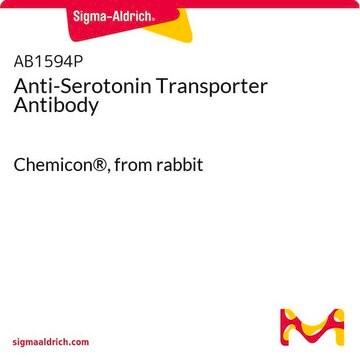MAB5618
Anti-Serotonin Transporter Antibody
ascites fluid, Chemicon®
Synonym(s):
SERT
Sign Into View Organizational & Contract Pricing
All Photos(1)
About This Item
UNSPSC Code:
12352203
eCl@ss:
32160702
NACRES:
NA.41
Recommended Products
biological source
mouse
Quality Level
antibody form
ascites fluid
antibody product type
primary antibodies
clone
monoclonal
species reactivity
primate, human
should not react with
rat
manufacturer/tradename
Chemicon®
technique(s)
immunohistochemistry: suitable
isotype
IgG
NCBI accession no.
UniProt accession no.
shipped in
dry ice
target post-translational modification
unmodified
Gene Information
human ... HTT(3064) , SLC6A4(6532)
Specificity
Serotonin Transporter, human and non-human primate.
Immunogen
Synthetic peptide from human serotonin transporter.
Application
Anti-Serotonin Transporter Antibody detects level of Serotonin Transporter & has been published & validated for use in IH.
Immunohistochemistry: 1:500-1:1,000 on 10% formalin fixed, paraffin embedded tissue from human Medulla oblongata. Suggested antigen retrieval method is Heat Induced Epitope Retrieval (HIER): Citrate Buffer pH 6.0.
Optimal working dilutions must be determined by end user.
Optimal working dilutions must be determined by end user.
Research Category
Neuroscience
Neuroscience
Research Sub Category
Ion Channels & Transporters
Ion Channels & Transporters
Physical form
Ascites
Storage and Stability
Maintain at -20degC in undiluted aliquots for up to 6 months after date of receipt. Avoid repeated freeze/thaw cycles.
Legal Information
CHEMICON is a registered trademark of Merck KGaA, Darmstadt, Germany
Disclaimer
Unless otherwise stated in our catalog or other company documentation accompanying the product(s), our products are intended for research use only and are not to be used for any other purpose, which includes but is not limited to, unauthorized commercial uses, in vitro diagnostic uses, ex vivo or in vivo therapeutic uses or any type of consumption or application to humans or animals.
Not finding the right product?
Try our Product Selector Tool.
Storage Class Code
10 - Combustible liquids
WGK
WGK 1
Flash Point(F)
Not applicable
Flash Point(C)
Not applicable
Certificates of Analysis (COA)
Search for Certificates of Analysis (COA) by entering the products Lot/Batch Number. Lot and Batch Numbers can be found on a product’s label following the words ‘Lot’ or ‘Batch’.
Already Own This Product?
Find documentation for the products that you have recently purchased in the Document Library.
Cheryl D Stimpson et al.
Social cognitive and affective neuroscience, 11(3), 413-422 (2015-10-18)
Humans' closest living relatives are bonobos (Pan paniscus) and chimpanzees (Pan troglodytes), yet these great ape species differ considerably from each other in terms of social behavior. Bonobos are more tolerant of conspecifics in competitive contexts and often use sexual
C H Lew et al.
Molecular autism, 11(1), 12-12 (2020-02-07)
Williams syndrome (WS) and autism spectrum disorder (ASD) are neurodevelopmental disorders that demonstrate overlapping genetic associations, dichotomous sociobehavioral phenotypes, and dichotomous pathological differences in neuronal distribution in key social brain areas, including the prefrontal cortex and the amygdala. The serotonergic
E C C Castro et al.
Canadian respiratory journal, 2017, 9064046-9064046 (2017-03-21)
Introduction. Failure of the vascular pulmonary remodeling at birth often manifests as pulmonary hypertension (PHT) and is associated with a variety of neonatal lung disorders including a uniformly fatal developmental disorder known as alveolar capillary dysplasia with misalignment of pulmonary
Danielle N Jones et al.
The Journal of comparative neurology, 529(7), 1659-1668 (2020-10-07)
The genus Macaca is an ideal model for investigating the biological basis of primate social behavior from an evolutionary perspective. A significant amount of behavioral diversity has been reported among the macaque species, but little is known about the neural
Smriti Patodia et al.
Brain pathology (Zurich, Switzerland), 32(5), e13074-e13074 (2022-04-29)
Several lines of evidence link deficient serotonin function and SUDEP. Chronic treatment with serotonin reuptake inhibitors (SRIs) reduces ictal central apnoea, a risk factor for SUDEP. Reduced medullary serotonergic neurones, modulators of respiration in response to hypercapnia, were reported in
Our team of scientists has experience in all areas of research including Life Science, Material Science, Chemical Synthesis, Chromatography, Analytical and many others.
Contact Technical Service








